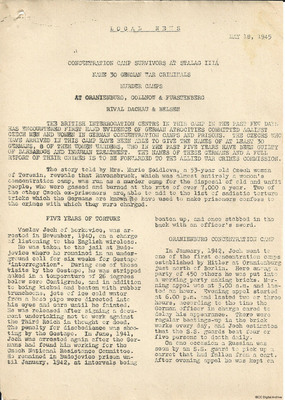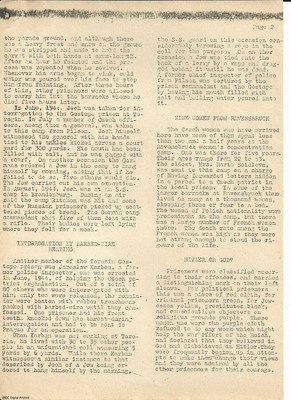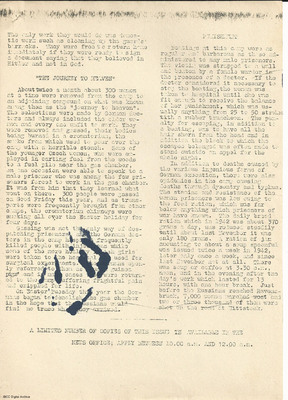Concentration Camp Survivors at Stalag 3A name 30 German war criminals
Title
Concentration Camp Survivors at Stalag 3A name 30 German war criminals
Warning. Contains graphic description of torture.
Description
A detailed description of atrocities committed by the Germans.
Date
1945-05-18
Temporal Coverage
Coverage
Language
Type
Format
Three typewritten sheets
Publisher
Rights
This content is available under a CC BY-NC 4.0 International license (Creative Commons Attribution-NonCommercial 4.0). It has been published ‘as is’ and may contain inaccuracies or culturally inappropriate references that do not necessarily reflect the official policy or position of the University of Lincoln or the International Bomber Command Centre. For more information, visit https://creativecommons.org/licenses/by-nc/4.0/ and https://ibccdigitalarchive.lincoln.ac.uk/omeka/legal.
Contributor
Identifier
SMansellEJ132971v20006-0001, SMansellEJ132971v20006-0002, SMansellEJ132971v20006-0003
Transcription
WARNING
GRAPHIC CONTENT
[page break]
[underlined] LOCAL NEWS [/underlined]
MAY 18, 1945
CONCENTRATION CAMP SURVIVORS AT STALAG IIIA NAME 30 GERMAN WAR CRIMINALS
MURDER CAMPS AT ORANIENBURG, GOLLNOW & FURSTENBERG RIVAL DACHAU & BELSEN
THE BRITISH INTERROGATION CENTRE IN THIS CAMP IN THE PAST FEW DAYS HAS ENCOUNTERED FIRST HAND EVIDENCE OF GERMAN ATROCITIES COMMITTED AGAINST CZECH MEN AND WOMEN IN GERMAN CONCENTRATION CAMPS AND PRISONS. THE CZECHS WHO HAVE ARRIVED IN THIS CAMP HAVE BEEN ABLE TO GIVE THE NAMES OF AT LEAST 30 GERMANS, 8 OF THEM WOMEN WARDERS, WHO IN THE PAST FIVE YEARS HAVE BEEN GUILTY OF BARBAROUS AND INHUMAN TREATMENT. THE NAMES OF THESE GERMANS AND A FULL REPORT OF THEIR CRIMES IS TO BE FORWARDED TO THE ALLIED WAR CRIMES COMMISSION.
The story told by Mrs. Marie Seidlova, a 53-year old Czech woman of Terezin, reveals that Ravensbruck, which was almost entirely a women’s concentration camp, was run as a murder camp for the disposal of old and unfit people, who were gassed and burned at the rate of over 7,000 a year. Two of the other Czech ex-prisoners are able to add to the list of sadistic torture tricks which the Germans are known to have used to make prisoners confess to the crimes with which they were charged.
FIVE YEARS OF TORTURE
Vaclav Jech of Borkovice, was arrested in November, 1940, on a charge of listening to the English wireless.
He was taken to the jail at Budejovice where he remained in an underground cell for six weeks for Gestapo “interrogation”. During one of these visits by the Gestapo, he was stripped naked in a temperature of 26 degrees below zero Centigrade, and in addition to being kicked and beaten with rubber truncheons, jets of ice cold water from a hose pipe were directed into his eyes and ears until he fainted. He was released after signing a document undertaking not to work against the Third Reich in thought or deed. The penalty for disobedience was shooting by the Gestapo. In June, 1941, Jech was arrested again after the Germans had found him working for the Czecjh National Resistance Committee. He remained in Budejovice prison until January, 1942, at intervals being beaten up, and once stabbed in the back with an officer’s sword.
ORANIENBURG CONCENTRATION CAMP
In January, 1942, Jech went to one of the first concentration camps established by Hitler at Oranienburg just north of Berlin. Here among a party of 450 others he was put into a working party making bricks. Morning appel was at 5.00 a.m. and lasted an hour. Evening appel started at 6.00 p.m. and lasted two or three hours, according to the time the German officer in charge cared to delay his appearance. There were regular beatings-up in the brick works every day, and Jech estimates that the S.S. guards beat four or five persons to death daily.
On one occasion a Russian was seen by an S.S. guard to pick up a carrot that had fallen from a cart. After evening appel he was kept on
[page break]
Page 2
the parade ground, and although there was a heavy frost and snow on the ground he was stripped and made to hold the carrot with both hands at arms-length. After an hour he fainted and the process was repeated when he revived. Whenever his arms began to sink, cold water was poured over his face to stop him from fainting. After three hours of this, other prisoners were allowed to carry him into the barracks where he died five hours later.
In June, 1944, Jech was taken for interrogation to the Gestapo prison at Teregin. In July a number of Czech officers, among them a general, was taken to this camp from Pilsen. Jech himself witnessed the general with his hands tied to his ankles kicked across a court yard for 300 yards. His mouth had been filled with salt, and he was gagged with a scarf. On another occasion the Germans ordered a Jew in the camp to hang himself by morning, adding that if he failed to do so, five others would die. The Jew carried out his own execution. In August, 1944, Jech was at an S.S camp in Brandenburg. During an air raid the camp kitchen was hit and some of the Russian prisoners picked up scattered pieces of bread. The German camp commandant shot five of them dead with a rifle. Their bodies were left lying where they fell for a week.
INTERROGATION BY BARBED-WIRE BEATING
Another member of the Terezin Gestapo prison was Jaroslav Karban, a former police inspector, who was arrested in June, 1944, of helping the Czech patriot organisation. Out of a total of 80 others who were interrogated with him, only two were released, the remainder were beaten with rubber truncheons packed with barbed-wire until they confessed. One prisoner had his front teeth knocked down his throat during interrogation and had to be sent to Prague for an operation.
When Karban was not working at Terezin, he lived with 30 to 35 other people in an unfurnished cell measuring 5 yards by 6 yards. While there Karban witnessed a similar instance to that described by Jech of a Jew being ordered to hang himself by the morning, the S.S. guard on this occasion considerately throwing a rope in the cell for the purpose. On another occasion a Jew was tied onto the back of a lorry by a rope and dragged behind it until he was dead.
A former chief inspector of police from Pilsen was tortured by the prison commandant and the Gestapo by having his mouth filled with salt and boiling water poured into it.
NINE WOMEN FROM RAVENSBRUCK
The Czech women who have arrived here have none of them spent less than two and a half years at the Ravensbruck women’s concentration camp. One was there for five years. Their ages range from 22 to 53.
The oldest, Mrs. Marie Seidlova, was sent to this camp on a charge of having forwarded letters hidden in a parcel to a Czech patriot in the local prison. In some of the larger barracks at Ravensbruck there lived as many as a thousand women, sleeping three of four to a bed.
The women of Polish nationality were predominant in the camp, but there was a large number of French women there. The death rate among the French women was high as they were not strong enough to stand the rigours of the life.
HITLER OR GOD?
Prisoners were classified according to their offences, and carried a distinguishing mark on their left sleeve. For political prisoners this was a piece of red cloth, for criminal prisoners green, for Jewesses yellow, prostitutes black, and conscientious objectors on religious grounds purple. These women who wore the purple cloth refused to do any work which might help the war effort of the Reich, and declared that they believed in God and disbelieved in Hitler. They were frequently beaten up in attempts to make them change their views and they were admired by all the other prisoners for their courage.
[page break]
The only work they would do was domestic work such as cleaning up the guards barracks. They were free to return home immediately if they were ready to sign a document saying that they believed in Hitler and not in God.
“THE JOURNEY TO HEAVEN”
About twice a month about 300 women at a time were removed from the camp to an adjoining compound on what was known among them as the “journey to heaven”. The selections were made by German doctors and always included the older women and every one unfit to work. They were removed and gassed, their bodies being burned in a crematorium, the smoke from which used to pour over the camp with a horrible stench. Some of the younger Czech women, who were employed in carting fuel from the woods to a fuel pile near the gas chamber, on one occasion were able to speak to a male prisoner who was among the few prisoners forced to work in the gas chamber. It was from him that they learned what went on there. 300 people were gassed on Good Friday this year, and as transports were frequently brought from other camps, the crematorium chimneys were smoking all over the Easter holiday for four days.
Gassing was not the only way of despatching prisoners and the German doctors in the camp hospital frequently killed people with injections while some of the more healthy Polish girls were taken to the hospital and used for surgical experiments. The Germans openly referred to them as “human guinea pigs” and in many cases they were returned to the camp suffering frightful pain and crippled for life.
On Easter Tuesday this year the Germans began to demolish the gas chamber in the hope that the Russians would find no trace when they arrived.
PUNISHMENT
Beatings at this camp were as regular and barbarous as those administered to any male prisoners. The victim was strapped to a wall and beaten by a female warder in the presence of a doctor. If the doctor considered it necessary to stop the beating, the woman was taken to hospital until she was fit enough to receive the balance of her punishment, which was usually anything from 25 to 50 strokes with a rubber truncheon. The penalty for escaping, in addition to a beating, was to have all the hair shorn from the head and in addition the block to which the escapee belonged was often made to stand outside on appel for the whole night.
In addition to deaths caused by the various ingenious forms of German execution, there were also epidemics in the camp causing deaths through dysentery and typhus. The stamina and resistance of the women prisoners was low owing to the food ration, which was far below anything which prisoners of war have known. The daily bread ration which in 1942 was about 370 grams a day, was reduced steadily until about last November it was only 180 grams. A ration of jam amounted to about a soup spoonful was issued twice a week in 1942, later only once a week, and since last November not at all. There was soup or coffee at 3.30 a.m., noon, and in the evening after the day’s work which lasted for 13 hours, with one hour break. Just before the Russians reached Ravensbruck, 7,000 women marched west and two or three thousand of them were shot on the road at Wittstock.
A LIMITED NUMBER OF COPIES OF THIS ISSUE IS AVAILABLE IN THE NEWS OFFICE; APPLY BETWEEN 10.00 a.m. AND 12.00 a.m.
GRAPHIC CONTENT
[page break]
[underlined] LOCAL NEWS [/underlined]
MAY 18, 1945
CONCENTRATION CAMP SURVIVORS AT STALAG IIIA NAME 30 GERMAN WAR CRIMINALS
MURDER CAMPS AT ORANIENBURG, GOLLNOW & FURSTENBERG RIVAL DACHAU & BELSEN
THE BRITISH INTERROGATION CENTRE IN THIS CAMP IN THE PAST FEW DAYS HAS ENCOUNTERED FIRST HAND EVIDENCE OF GERMAN ATROCITIES COMMITTED AGAINST CZECH MEN AND WOMEN IN GERMAN CONCENTRATION CAMPS AND PRISONS. THE CZECHS WHO HAVE ARRIVED IN THIS CAMP HAVE BEEN ABLE TO GIVE THE NAMES OF AT LEAST 30 GERMANS, 8 OF THEM WOMEN WARDERS, WHO IN THE PAST FIVE YEARS HAVE BEEN GUILTY OF BARBAROUS AND INHUMAN TREATMENT. THE NAMES OF THESE GERMANS AND A FULL REPORT OF THEIR CRIMES IS TO BE FORWARDED TO THE ALLIED WAR CRIMES COMMISSION.
The story told by Mrs. Marie Seidlova, a 53-year old Czech woman of Terezin, reveals that Ravensbruck, which was almost entirely a women’s concentration camp, was run as a murder camp for the disposal of old and unfit people, who were gassed and burned at the rate of over 7,000 a year. Two of the other Czech ex-prisoners are able to add to the list of sadistic torture tricks which the Germans are known to have used to make prisoners confess to the crimes with which they were charged.
FIVE YEARS OF TORTURE
Vaclav Jech of Borkovice, was arrested in November, 1940, on a charge of listening to the English wireless.
He was taken to the jail at Budejovice where he remained in an underground cell for six weeks for Gestapo “interrogation”. During one of these visits by the Gestapo, he was stripped naked in a temperature of 26 degrees below zero Centigrade, and in addition to being kicked and beaten with rubber truncheons, jets of ice cold water from a hose pipe were directed into his eyes and ears until he fainted. He was released after signing a document undertaking not to work against the Third Reich in thought or deed. The penalty for disobedience was shooting by the Gestapo. In June, 1941, Jech was arrested again after the Germans had found him working for the Czecjh National Resistance Committee. He remained in Budejovice prison until January, 1942, at intervals being beaten up, and once stabbed in the back with an officer’s sword.
ORANIENBURG CONCENTRATION CAMP
In January, 1942, Jech went to one of the first concentration camps established by Hitler at Oranienburg just north of Berlin. Here among a party of 450 others he was put into a working party making bricks. Morning appel was at 5.00 a.m. and lasted an hour. Evening appel started at 6.00 p.m. and lasted two or three hours, according to the time the German officer in charge cared to delay his appearance. There were regular beatings-up in the brick works every day, and Jech estimates that the S.S. guards beat four or five persons to death daily.
On one occasion a Russian was seen by an S.S. guard to pick up a carrot that had fallen from a cart. After evening appel he was kept on
[page break]
Page 2
the parade ground, and although there was a heavy frost and snow on the ground he was stripped and made to hold the carrot with both hands at arms-length. After an hour he fainted and the process was repeated when he revived. Whenever his arms began to sink, cold water was poured over his face to stop him from fainting. After three hours of this, other prisoners were allowed to carry him into the barracks where he died five hours later.
In June, 1944, Jech was taken for interrogation to the Gestapo prison at Teregin. In July a number of Czech officers, among them a general, was taken to this camp from Pilsen. Jech himself witnessed the general with his hands tied to his ankles kicked across a court yard for 300 yards. His mouth had been filled with salt, and he was gagged with a scarf. On another occasion the Germans ordered a Jew in the camp to hang himself by morning, adding that if he failed to do so, five others would die. The Jew carried out his own execution. In August, 1944, Jech was at an S.S camp in Brandenburg. During an air raid the camp kitchen was hit and some of the Russian prisoners picked up scattered pieces of bread. The German camp commandant shot five of them dead with a rifle. Their bodies were left lying where they fell for a week.
INTERROGATION BY BARBED-WIRE BEATING
Another member of the Terezin Gestapo prison was Jaroslav Karban, a former police inspector, who was arrested in June, 1944, of helping the Czech patriot organisation. Out of a total of 80 others who were interrogated with him, only two were released, the remainder were beaten with rubber truncheons packed with barbed-wire until they confessed. One prisoner had his front teeth knocked down his throat during interrogation and had to be sent to Prague for an operation.
When Karban was not working at Terezin, he lived with 30 to 35 other people in an unfurnished cell measuring 5 yards by 6 yards. While there Karban witnessed a similar instance to that described by Jech of a Jew being ordered to hang himself by the morning, the S.S. guard on this occasion considerately throwing a rope in the cell for the purpose. On another occasion a Jew was tied onto the back of a lorry by a rope and dragged behind it until he was dead.
A former chief inspector of police from Pilsen was tortured by the prison commandant and the Gestapo by having his mouth filled with salt and boiling water poured into it.
NINE WOMEN FROM RAVENSBRUCK
The Czech women who have arrived here have none of them spent less than two and a half years at the Ravensbruck women’s concentration camp. One was there for five years. Their ages range from 22 to 53.
The oldest, Mrs. Marie Seidlova, was sent to this camp on a charge of having forwarded letters hidden in a parcel to a Czech patriot in the local prison. In some of the larger barracks at Ravensbruck there lived as many as a thousand women, sleeping three of four to a bed.
The women of Polish nationality were predominant in the camp, but there was a large number of French women there. The death rate among the French women was high as they were not strong enough to stand the rigours of the life.
HITLER OR GOD?
Prisoners were classified according to their offences, and carried a distinguishing mark on their left sleeve. For political prisoners this was a piece of red cloth, for criminal prisoners green, for Jewesses yellow, prostitutes black, and conscientious objectors on religious grounds purple. These women who wore the purple cloth refused to do any work which might help the war effort of the Reich, and declared that they believed in God and disbelieved in Hitler. They were frequently beaten up in attempts to make them change their views and they were admired by all the other prisoners for their courage.
[page break]
The only work they would do was domestic work such as cleaning up the guards barracks. They were free to return home immediately if they were ready to sign a document saying that they believed in Hitler and not in God.
“THE JOURNEY TO HEAVEN”
About twice a month about 300 women at a time were removed from the camp to an adjoining compound on what was known among them as the “journey to heaven”. The selections were made by German doctors and always included the older women and every one unfit to work. They were removed and gassed, their bodies being burned in a crematorium, the smoke from which used to pour over the camp with a horrible stench. Some of the younger Czech women, who were employed in carting fuel from the woods to a fuel pile near the gas chamber, on one occasion were able to speak to a male prisoner who was among the few prisoners forced to work in the gas chamber. It was from him that they learned what went on there. 300 people were gassed on Good Friday this year, and as transports were frequently brought from other camps, the crematorium chimneys were smoking all over the Easter holiday for four days.
Gassing was not the only way of despatching prisoners and the German doctors in the camp hospital frequently killed people with injections while some of the more healthy Polish girls were taken to the hospital and used for surgical experiments. The Germans openly referred to them as “human guinea pigs” and in many cases they were returned to the camp suffering frightful pain and crippled for life.
On Easter Tuesday this year the Germans began to demolish the gas chamber in the hope that the Russians would find no trace when they arrived.
PUNISHMENT
Beatings at this camp were as regular and barbarous as those administered to any male prisoners. The victim was strapped to a wall and beaten by a female warder in the presence of a doctor. If the doctor considered it necessary to stop the beating, the woman was taken to hospital until she was fit enough to receive the balance of her punishment, which was usually anything from 25 to 50 strokes with a rubber truncheon. The penalty for escaping, in addition to a beating, was to have all the hair shorn from the head and in addition the block to which the escapee belonged was often made to stand outside on appel for the whole night.
In addition to deaths caused by the various ingenious forms of German execution, there were also epidemics in the camp causing deaths through dysentery and typhus. The stamina and resistance of the women prisoners was low owing to the food ration, which was far below anything which prisoners of war have known. The daily bread ration which in 1942 was about 370 grams a day, was reduced steadily until about last November it was only 180 grams. A ration of jam amounted to about a soup spoonful was issued twice a week in 1942, later only once a week, and since last November not at all. There was soup or coffee at 3.30 a.m., noon, and in the evening after the day’s work which lasted for 13 hours, with one hour break. Just before the Russians reached Ravensbruck, 7,000 women marched west and two or three thousand of them were shot on the road at Wittstock.
A LIMITED NUMBER OF COPIES OF THIS ISSUE IS AVAILABLE IN THE NEWS OFFICE; APPLY BETWEEN 10.00 a.m. AND 12.00 a.m.
Collection
Citation
“Concentration Camp Survivors at Stalag 3A name 30 German war criminals,” IBCC Digital Archive, accessed November 5, 2024, https://ibccdigitalarchive.lincoln.ac.uk/omeka/collections/document/49354.
Item Relations
This item has no relations.




